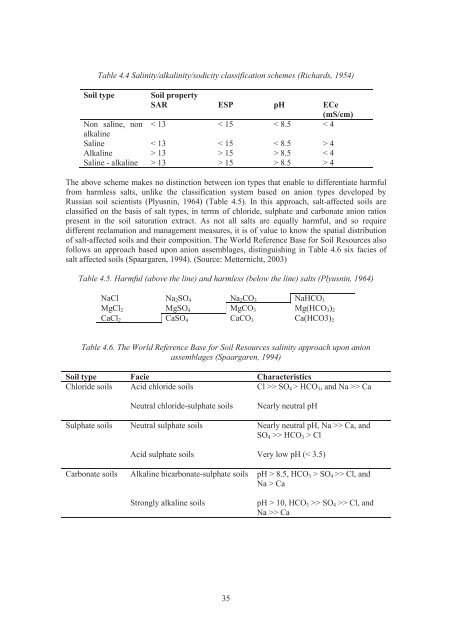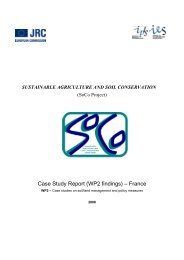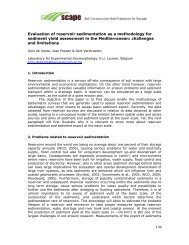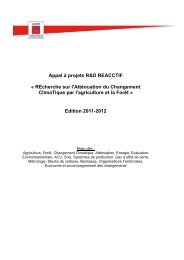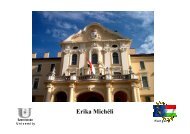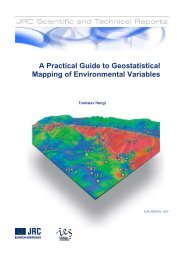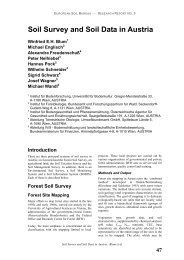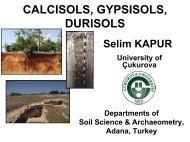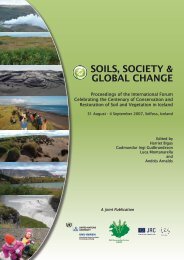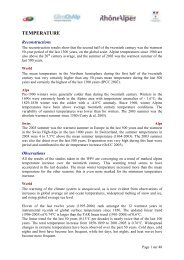Risk Assessment Methodologies of Soil Threats in Europe
Risk Assessment Methodologies of Soil Threats in Europe
Risk Assessment Methodologies of Soil Threats in Europe
You also want an ePaper? Increase the reach of your titles
YUMPU automatically turns print PDFs into web optimized ePapers that Google loves.
Table 4.4 Sal<strong>in</strong>ity/alkal<strong>in</strong>ity/sodicity classification schemes (Richards, 1954)<br />
<strong>Soil</strong> type <strong>Soil</strong> property<br />
SAR ESP pH ECe<br />
(mS/cm)<br />
Non sal<strong>in</strong>e, non < 13 < 15 < 8.5 < 4<br />
alkal<strong>in</strong>e<br />
Sal<strong>in</strong>e < 13 < 15 < 8.5 > 4<br />
Alkal<strong>in</strong>e > 13 > 15 > 8.5 < 4<br />
Sal<strong>in</strong>e - alkal<strong>in</strong>e > 13 > 15 > 8.5 > 4<br />
The above scheme makes no dist<strong>in</strong>ction between ion types that enable to differentiate harmful<br />
from harmless salts, unlike the classification system based on anion types developed by<br />
Russian soil scientists (Plyusn<strong>in</strong>, 1964) (Table 4.5). In this approach, salt-affected soils are<br />
classified on the basis <strong>of</strong> salt types, <strong>in</strong> terms <strong>of</strong> chloride, sulphate and carbonate anion ratios<br />
present <strong>in</strong> the soil saturation extract. As not all salts are equally harmful, and so require<br />
different reclamation and management measures, it is <strong>of</strong> value to know the spatial distribution<br />
<strong>of</strong> salt-affected soils and their composition. The World Reference Base for <strong>Soil</strong> Resources also<br />
follows an approach based upon anion assemblages, dist<strong>in</strong>guish<strong>in</strong>g <strong>in</strong> Table 4.6 six facies <strong>of</strong><br />
salt affected soils (Spaargaren, 1994). (Source: Metternicht, 2003)<br />
Table 4.5. Harmful (above the l<strong>in</strong>e) and harmless (below the l<strong>in</strong>e) salts (Plyusn<strong>in</strong>, 1964)<br />
NaCl Na2SO4 Na2CO3 NaHCO3<br />
MgCl2 MgSO4 MgCO3 Mg(HCO3)2<br />
CaCl2 CaSO4 CaCO3 Ca(HCO3)2<br />
Table 4.6. The World Reference Base for <strong>Soil</strong> Resources sal<strong>in</strong>ity approach upon anion<br />
assemblages (Spaargaren, 1994)<br />
<strong>Soil</strong> type Facie Characteristics<br />
Chloride soils Acid chloride soils Cl >> SO4 > HCO3, and Na >> Ca<br />
Neutral chloride-sulphate soils Nearly neutral pH<br />
Sulphate soils Neutral sulphate soils Nearly neutral pH, Na >> Ca, and<br />
SO4 >> HCO3 > Cl<br />
Acid sulphate soils Very low pH (< 3.5)<br />
Carbonate soils Alkal<strong>in</strong>e bicarbonate-sulphate soils pH > 8.5, HCO3 > SO4 >> Cl, and<br />
Na > Ca<br />
Strongly alkal<strong>in</strong>e soils pH > 10, HCO3 >> SO4 >> Cl, and<br />
Na >> Ca<br />
35


